Released in 1985 to critical acclaim, Elem Klimov’s “Come and See” is not an underrated film – those who see it are quick to recognize its excellence. It is, however, a criminally underseen one, most likely because of where and when it was made (more on that later).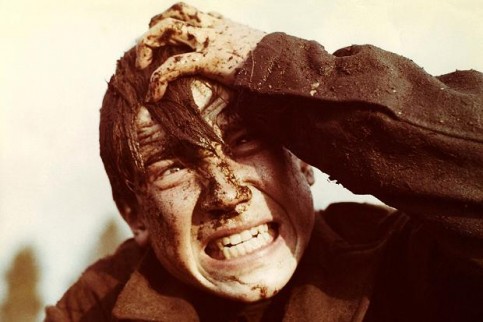
Additionally, it has no big stars or familiar faces to speak of, and no sweeping score characteristic of your typical Hollywood spectacle. It is long, but not prohibitively so (at 142 minutes, it’s certainly shorter than other respected films in the genre, and even many of today’s blockbusters). It’s an undeniably well-made movie, featuring unmistakably high production values, but not a particularly beautiful one (not that it was trying to be).
The plot is simple: In 1943, a young teenage boy in the Socialist Soviet Republic of Byelorussia (modern-day Belarus) sets out to join the partisans in the fight against the Nazis during the occupation. His harrowing but sadly all-too plausible experiences make up the rest of the film, resulting in one of the most shocking and powerful chronicles of war and its effects in all of cinema.
Relentlessly grim, deeply disturbing, and made unquestionably more dread-inducing by the fact that almost everything depicted really happened (and then some), it is a depressing but necessary reminder of one of the darkest chapters in human history. That it also manages to be both poetic and realistic is a supreme accomplishment on the part of the director.
Not all movies are meant to be enjoyable, and some fall more obviously into the category of art than entertainment. Though no one could possible describe the experience of watching “Come and See” as a fun time, the film is nonetheless a masterpiece, worthy of consideration as not just the best war movie ever made, but also one of the greatest films ever made PERIOD. The following are just ten of the reasons why its legacy should be so honored:
A Sympathetic Protagonist
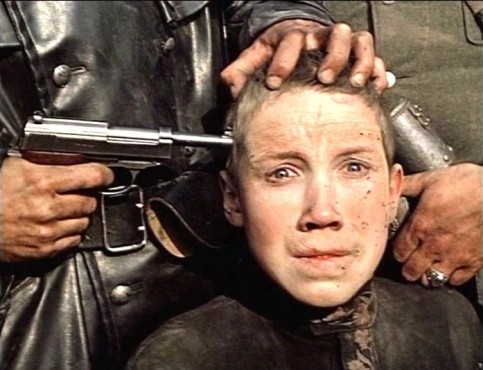
One of the major keys to the film’s success is its main character. The entire story is told from the perspective of Florya, an idealistic peasant eager to join the resistance. Played by newcomer Aleksei Kravchenko, who was only fourteen when the film was made, Florya becomes the surrogate witness through which the audience experiences the brutality of war.
By casting such a young actor, Klimov sets up one of the basic themes of the film: the death of innocence. While hardly a unique message for a war movie, the striking and totally believable transformation Florya undergoes over the course of the film is haunting and unforgettable. We watch as the boy literally ages before our eyes, gaining wrinkles and losing hair color as he faces one trauma after another.
It’s impossible to be unaffected by watching the ongoing emotional scarring of a person, especially one so young, and Kravchenko lives up the task by delivering a completely convincing performance. By the film’s end, he’s been rendered nearly mute by all he’s seen – a reaction that audiences will easily understand, if not briefly share.
Surrealism
The stylistic choices Klimov makes here separates the film from any other in the genre, none more so than his use of surrealism. The opening scene finds Florya and another boy digging in a sandy field. The reason isn’t immediately clear, though we soon find out they’re looking for rifles accompanying the bodies of soldiers buried in shallow graves. The strangeness of the scene establishes the consistently ominous and nightmarish tone that Klimov maintains for the duration of the film. The effect is extremely unsettling.
Though there are multiple examples of unexpected and upsetting details throughout, such as the moment early on when Florya unintentionally tramples on a nest full of bird eggs, the most jarring surrealistic moments are reserved for the film’s most horrifying sequence, in which an entire village is massacred by the Nazis. Amidst the chaos, an SS officer is seen playing with his pet loris (a rare and exotic primate).
A beautiful German woman listens to opera music and eats lobster in her car while the village burns around her (perhaps a visual mockery of supposed Aryan “civility”). It’s the bizarre touches like these that help burn the scene into our memory, as if showing just general mayhem would be too basic. What Klimov is after is something more impressionistic, punctuating the atrocities with images so weird and inexplicable that they almost come off as obscene, given their context.
Furthering that point, after herding the villagers into a wooden church and setting it on fire with grenades and flamethrowers, the Nazis indiscriminately open fire on the building, an action that’s not just overkill, but unnecessary to the point of absurdity. The spontaneous self-congratulatory applause they give themselves is the chilling topper to the carnage.
Though the film stays inherently committed to its realistic portrayal of the war, the occasional artistic flourishes Klimov includes work without robbing the film of its verisimilitude. Still, the frequency of these odd occurrences make it seem as though Klimov decided to shoot his war movie as if it were a horror movie, which brings us to the next point…
Music and Sound Design
If the strong imagery is the most memorable aspect of this movie, then its soundtrack comes in at a close second. Instead of a traditional score, a cacophonous mix of animal noises, droning hums, occasional excerpts of classical music, and of course, the expected terrible sounds of war are used.
This unorthodox approach succeeds magnificently in emphasizing the intensity onscreen, such as in the practically unbearable scene in which Florya and a young girl he’s befriended named Glasha wade across a quicksand-like bog in their search for fellow survivors.
Filmed in long takes that look as uncomfortable to have filmed as they are to watch, the audio in the scene consists mostly of unseen bird chirps and a low-frequency whir. The sudden appearance of waltz-like classical music creates a juxtaposition that puts the scene somewhere on the border between satirical and tragic.
Much of the infamous massacre scene goes un-scored, the sounds of screaming villagers, barking dogs, gunfire, and Nazi laughter being more than sufficient to supplement the visuals. Klimov knows well when to let the images speak for themselves, and also when silence is appropriate. In an early scene of a German bombing raid, Florya temporarily goes deaf. The audio takes his subjective point of view, resulting in us hearing the same ringing noise (the same technique was used years later in “Saving Private Ryan”).
Finally, the film’s last scene fittingly uses one of the saddest and most mournful pieces of music ever written: the Lacrimosa from Mozart’s Requiem. The piece has been used in countless other movies and TV shows, but Klimov absolutely earns the right to employ it here, given all that’s preceded it.
Realism
Despite the use of surrealism, the film as a whole remains thoroughly grounded in reality. Much of the realism is due to specific decisions made by the director, some of which sound questionable at best in retrospect.
In addition to filming on location in Belarus, in chronological order, and with dialogue spoken in authentic Belarusian, Russian, and German, live ammunition was used in several scenes instead of blanks, sometimes missing the actors by mere inches. Many of the uniforms seen in the film are not costumes, but genuine originals from the war itself. Most impressively, no professional trained actors were used, making the compelling performances and Klimov’s directing of them all the more praiseworthy.
By keeping the action restricted to Florya’s point of view, Klimov gives us a child soldier’s eye view of the destruction, with no flashbacks or outside cutaways to offer relief. And even though elements such as subjective sound and non-diegetic music are utilized, the uncompromising you-are-there feel of the film is never abandoned.
Historical Importance
If nothing else, “Come and See” offers a sobering history lesson, illuminating one of the lesser known episodes of World War II: the Nazi occupation of Belarus. While most films about the Nazi treatment of civilians understandably focus on what they did to the Jews – the minority that was indisputably singled out to receive the worst of the Nazi’s policies, culminating in the genocidal slaughter that was the Holocaust – there were many other religious, ethnic, and regional groups that were also selected for extermination.
In a 1986 interview, Klimov stated that the film was intended to be anti-war and anti-fascist, but not anti-German. That said, the movie’s narrow focus on the plainly despicable actions undertaken by the Nazis in the BSSR leaves little room for debate that, though the film aims to illustrate the horrors of war in general and fascism in particular, its main target is quite specific. The original title was “Kill Hitler,” and its change was thankfully the only one Klimov had to make from his vision.
From the opening scene, the film announces without ambiguity the nature and identity of the enemy. As the boys dig for weapons, they spot a German plane. The unmistakable voice of Adolf Hitler then fills the soundtrack, transitioning into the infamous first verse of the Deutschlandlied (the national anthem of the Third Reich) as the opening credits begin.
Later, Florya’s displaced fellow villagers, perhaps seeking a tangible object on which they can unload their collective outrage, construct a grotesque effigy of the Nazi leader. And of course, there’s the use of Nazi footage in the brilliant climax of the film (to be discussed later).
Unlike in some other war movies, the enemy is far from faceless here – the notorious massacre scene at the end of the film features plenty of German dialogue and swastikas galore. By being explicit about who the film is about, Klimov is better able to make his point about war in general (as any true artist knows, tragedy is almost always more moving when it focuses on the small to make a point about the large, rather than trying to be too thorough and comprehensive).
And just to make sure there’s no doubt about why this particular army of murderous soldiers commits the actions it does in the film (as if it could hypothetically be some hideous anomaly), the Obersturmführer bluntly evokes Nazi ideology (even after being captured, no less), confidently stating that the Byelorussian partisans are members of an inferior race that has no right to exist. This important bit of dialogue proves that his and his men’s actions directly stem from official orders.
Some may wonder if it’s really necessary to continue making films showing just how bad the Nazis were, while others may take offense at the very question. A more intriguing thought would be whether or not the film would still be great if it weren’t based on true events, though reality may render this a moot point.
Of course, it would still indeed be exceptional, but probably not as disquieting, most likely. That it’s unabashedly political and anti-Nazi is of course not controversial, as the text and images at the end of the film give us a stark reminder of why films like this need to be made.
Imagery of War – Knowing What To Show And What Not To Show
The film is unique in not containing the traditional war movie tropes viewers are accustomed to seeing. The film has no battle scenes, no feats of heroism or self-sacrifice, no sentimentality or trite love story. Florya does befriend Glasha early in the film, but after he leaves her behind with the other survivors of his village, we never see what becomes of her.
Only later in the film do we see a young woman markedly similar to her in appearance, the blood streaming down her thighs implying a gang rape (mercifully off-screen), perhaps hinting at Glasha’s fate.
When dealing with such repulsive material, it could be easy to fall into the trap of exploitation. Luckily, Klimov has good instincts, imbuing the film with an undercurrent of horror while neither overdoing the onscreen violence nor sugarcoating it. It is indeed a violent film, without question, but the bloodshed is neither graphically portrayed nor gratuitous.
In the climactic scene in which the population of an entire village is burned alive, the conflagration is only shown from the outside – hearing everything is more than enough to turn our stomachs. There’s nothing shown here that would have made the MPAA question whether the film deserved anything more than an R rating (it is, for the record, not rated), as Klimov uses relative restraint, objectively speaking.
Witnessing the war firsthand as a child, he once said, “As a young boy, I had been in hell… Had I included everything I knew and shown the whole truth, even I could not have watched it.”
Instead, he uses the technique of visual synecdoche, composing potent tableaus to represent the broad scope of Nazi sadism and ruthlessness. Rather than show gruesome scenes of physical torture or executions framed in bloody close-ups, Klimov instead gives us moments like the one in which the Nazis save an elderly woman from the blaze, joking that she’ll be a breeder for future generations.
In another, a Nazi officer holds a pistol to Florya’s head in mock execution merely for the purpose of staging a commemorative photograph (the gut-wrenching image was used as one version of the film’s poster and video cover).
Long takes are used throughout the appalling sequence, and the score is kept to a minimum. And yet, despite the ugliness of everything onscreen, the film isn’t necessarily an over-two-hour slog through the worst of humanity – a scene early on in which Glasha dances in a sunstorm offers a brief respite. It’s a necessary instance of levity that makes the later scenes all the more frightful by contrast.
Self-Assured and Masterful Directing
If it’s not already apparent by now, Elem Klimov’s directing is largely the reason why the film succeeds as well as it does. It’s honestly hard to find a single flaw in it. From the skillful use of music, sound, and color, to the hyper-realistic sets, costumes, performances, to the fluid but not showy cinematography that makes heavy use of the Steadicam, virtually every choice made seems like the correct one. It is also worth mentioning here the contributions of Ales Adamovich, the co-writer.
The film is mostly inspired by his experiences during the war, as he was the same age as Florya and fought with the partisans when the Nazis occupied his country of the Byelorussian SSR. Together with Klimov’s own recollections, the two create a startling portrait of the war from the perspective of the Soviet partisans.
It is significant and worth nothing that not only was this great war movie made outside of Hollywood, but that the filmmakers behind it were themselves victims of the tragedy it depicts (Oliver Stone would make “Platoon,” his similarly personal Oscar-winning film, just a year later). “Come and See” is less well known than many other war films, of course, because it was made in the Soviet Union during the Cold War.
But was it propaganda? As explained earlier, it’s certainly anti-fascist (again, little controversy there), but that it was ultimately allowed to film, without censorship (aside from he simple title change), in order to commemorate the 40th anniversary of the Soviet victory is quite telling. Yes, the partisans eventually do triumph, but at what cost? No one viewing the film could mistake it for glorifying the realities of warfare. Brutal as it is, nothing shown is really that exaggerated, unfortunately.
The film was, at least, a box office success in the USSR, though Klimov never made another. Claiming that he’d already done everything he thought possible, he made no more films in the eighteen years between the release of “Come and See” and his death in 2003. If that doesn’t say something about his confidence in the film’s power, what does?
A Fitting Title
It may seem relatively inconsequential, but titles matter (anyone who thinks otherwise may want to consider the disappointing box office performance of the “everything-was-great-but-the-title” case of “The Shawshank Redemption”). With this film’s moniker, nothing could have described its content better. For those not too familiar with the New Testament, the title refers to the sixth chapter of the Book of Revelation. In it, John is invited to look upon the desolation wrought by the Four Horsemen of the Apocalypse:
“And when he had opened the fourth seal, I heard the voice of the fourth beast say, Come and see. And I looked, and behold a pale horse: and his name that sat on him was Death, and Hell followed with him. And power was given unto them over the fourth part of the earth, to kill with sword, and with hunger, and with death, and with the beasts of the earth.”
If there were ever a war movie that depicted manmade hell-on-earth, this one is it. Referencing the final apocalyptic book of the New Testament in pop culture is nothing new, of course – after all, Francis Ford Coppola used the title “Apocalypse Now” for his Vietnam War epic, and Johnny Cash literally speaks the above verse in his song, “The Man Comes Around.” Few, however, will quarrel with the application of those menacing ancient words here.
Powerful and Complex Themes
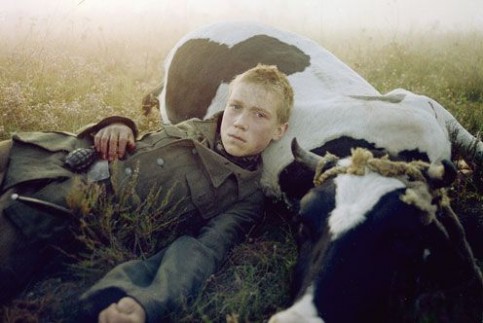
When making a movie about such a tough real life subject, it’s important to have something unique to say. The message here is not so simple as debunking the notion that fighting in a war could be fun, which was likely much more commonly believed in the days before the ubiquity of mass media.
While the movie does begin with Florya excitedly volunteering to join the partisans, he realizes well before the midpoint of the film that his spirited optimism was horribly misguided. The film, of course, does not end there, its remainder giving us a searing account of war essentially from a child’s perspective. Florya never ends up killing anyone, but rather, becomes a helpless victim and witness to the savage assault on his homeland.
In addition to topics like the chaos of war and the loss of innocence, the issues of vengeance and justice are clearly of deep concern for Klimov. Following the fiery village massacre, Florya returns to find that the partisans have managed to capture some of the Germans and their Byelorussian collaborators.
There’s a short debate about what to do with the prisoners, and they’re eventually doused with petrol in preparation for some eye-for-an-eye-style punishment. Before they can be set aflame, however, the partisans with rifles shoot the bound men to death. While even the staunchest death penalty opponents will find it hard to be upset by this swift execution of confessed war criminals, the quiet aftermath gives us pause.
Justice is served, but is there any satisfaction? The damage has already been done, and the response of the villagers, while certainly understandable, makes one wonder, not just about what becoming an executioner does to a person, but about the place of justice in a world that seems utterly bereft of the concept of good and evil anymore.
The Climax and Ending
Even given the high quality of everything that’s come before it, the most indelible and inventive sequence in “Come and See” is the one Klimov saves for last. Following the execution of the captured Germans and their collaborators, Florya finds a framed portrait of Adolf Hitler in a mud puddle. Using his rifle for the first time in the film, he begins to shoot it, each squeeze of the trigger intercut with archival footage, moving backwards and in reverse chronology.
Real video recordings of emaciated concentration camp victims give way to the last documented footage of Hitler at the Führerbunker, to images of aerial bombardment, Nazi rallies, and eventually, still photos of Hitler as a young man, a child, and finally, a baby. The real life context provides a kinetic gut punch to the audience (as if it could forget that these events really happened), as actually seeing the horrible visuals makes it all hit home in a way that no recreation, no matter how accurate, truly could.
Like the scene with the Hitler effigy and the unused title, this scene again reminds us just how crucial the identities of the villains in this film are to the story Klimov is trying to tell. This is not only a film about war, but one specifically about the evils of Hitler and National Socialism.
A single title card at the end simply states: “The Nazis burned 628 Byelorussian villages to the ground with all their inhabitants.” That an exact figure can be tied to the butchery makes it even more unimaginable. If there were anything that could convince us that the film wasn’t just an exercise in nihilism, it’s this breathtaking fact. Knowing that the realistic but fictional village massacre scene represents a mere fraction of what actually occurred is almost beyond comprehension.
But back to the “rewinding history” montage. When the footage reaches its final image – the first known photo taken of Hitler as a baby, Florya finds himself unable to fire. The reasons are open to interpretation, though perhaps it’s the simple reminder that the man whose name is now used as basically a shorthand for evil was just that – a man, one who didn’t emerge from another universe or dimension, but who came into the world in the same unremarkable way as the rest of us.
Florya, now looking like he’s at least ten years older, stares into space as the strains of Mozart’s Requiem begin. Another boy, not so different-looking than how Florya appeared at the film’s beginning, goes off to accompany the partisans as they head out. The ending is not just a downer, but one that implies that the cycle of shattered innocence will begin again anew.
The knowledge that the Nazis are ultimately defeated gives us little comfort given what we’ve been through, which is what watching the film feels like – an ordeal. The ending is suitably harsh, though the fact that Florya doesn’t die, but survives as an eyewitness can perhaps provide some comfort. Clearly he’ll never be the same, but then again, neither will we.
The camera looks up from the marching soldiers to the trees to the sky, as if questioning the nature or even the very existence of God… and then the movie’s over. No end credits. If such a finale doesn’t leave you in either tears or stunned silence, nothing will. It’s the right ending for this story, a monumental cinematic testament to the all-encompassing awfulness of war and man’s capacity for cruelty.
Yes, there are witnesses and survivors and the bad guys are beaten for now, but the note the film ends on could never rightfully be called hopeful. Like a figurative sledgehammer to the psyche, the impact of this bleak work of art is both devastating and hauntingly beautiful. You’ll leave the theater feeling drained, but definitely grateful for having had this singular viewing experience.
Jason Turer

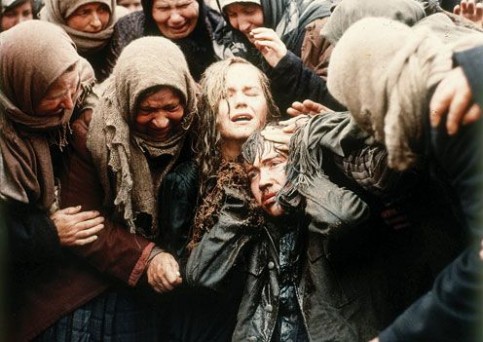
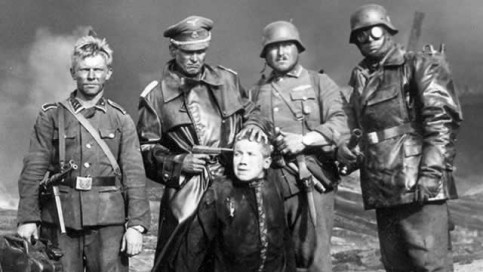
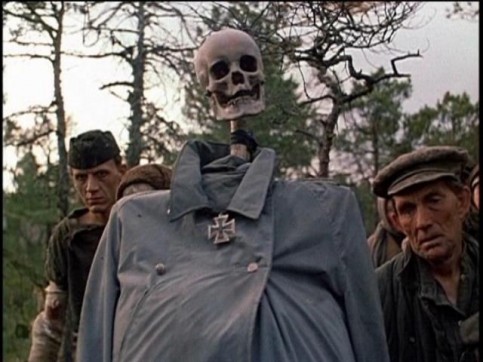
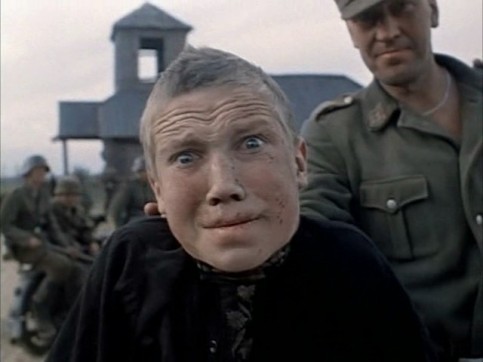
You must be logged in to post a comment Login